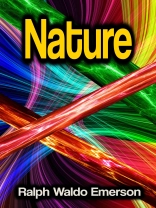Nature Ralph Waldo Emerson – Nature is an essay written by Ralph Waldo Emerson, published by James Munroe and Company in 1836. In the essay Emerson put forth the foundation of transcendentalism, a belief system that espouses a non-traditional appreciation of nature. Transcendentalism suggests that the divine, or God, suffuses nature, and suggests that reality can be understood by studying nature. Emerson’s visit to the Muséum National d’Histoire Naturelle in Paris inspired a set of lectures he later delivered in Boston which were then published. Within the essay, Emerson divides nature into four usages: Commodity, Beauty, Language and Discipline. These distinctions define the ways by which humans use nature for their basic needs, their desire for delight, their communication with one another and their understanding of the world.Emerson followed the success of Nature with a speech, ‘The American Scholar’, which together with his previous lectures laid the foundation for transcendentalism and his literary career.
Over de auteur
In 1803, Ralph Waldo Emerson was born in Boston. Educated at Harvard and the Cambridge Divinity School, he became a Unitarian minister in 1826 at the Second Church Unitarian. The congregation, with Christian overtones, issued communion, something Emerson refused to do. ‘Really, it is beyond my comprehension, ‘ Emerson once said, when asked by a seminary professor whether he believed in God. (Quoted in 2, 000 Years of Freethought edited by Jim Haught.) By 1832, after the untimely death of his first wife, Emerson cut loose from Unitarianism. During a year-long trip to Europe, Emerson became acquainted with such intelligentsia as British writer Thomas Carlyle, and poets Wordsworth and Coleridge. He returned to the United States in 1833, to a life as poet, writer and lecturer. Emerson inspired Transcendentalism, although never adopting the label himself. He rejected traditional ideas of deity in favor of an ‘Over-Soul’ or ‘Form of Good, ‘ ideas which were considered highly heretical. His books include Nature (1836), The American Scholar (1837), Divinity School Address (1838), Essays, 2 vol. (1841, 1844), Nature, Addresses and Lectures (1849), and three volumes of poetry. Margaret Fuller became one of his ‘disciples, ‘ as did Henry David Thoreau.
The best of Emerson’s rather wordy writing survives as epigrams, such as the famous: ‘A foolish consistency is the hobgoblin of little minds, adored by little statesmen and philosophers and divines.’ Other one- (and two-) liners include: ‘As men’s prayers are a disease of the will, so are their creeds a disease of the intellect’ (Self-Reliance, 1841). ‘The most tedious of all discourses are on the subject of the Supreme Being’ (Journal, 1836). ‘The word miracle, as pronounced by Christian churches, gives a false impression; it is a monster. It is not one with the blowing clover and the falling rain’ (Address to Harvard Divinity College, July 15, 1838). He demolished the right wing hypocrites of his era in his essay ‘Worship’: ‘. . . the louder he talked of his honor, the faster we counted our spoons’ (Conduct of Life, 1860). ‘I hate this shallow Americanism which hopes to get rich by credit, to get knowledge by raps on midnight tables, to learn the economy of the mind by phrenology, or skill without study, or mastery without apprenticeship’ (Self-Reliance). ‘The first and last lesson of religion is, ‘The things that are seen are temporal; the things that are not seen are eternal.’ It puts an affront upon nature’ (English Traits , 1856). ‘The god of the cannibals will be a cannibal, of the crusaders a crusader, and of the merchants a merchant.’ (Civilization, 1862). He influenced generations of Americans, from his friend Henry David Thoreau to John Dewey, and in Europe, Friedrich Nietzsche, who takes up such Emersonian themes as power, fate, the uses of poetry and history, and the critique of Christianity. D. 1882.
Ralph Waldo Emerson was his son and Waldo Emerson Forbes, his grandson.












